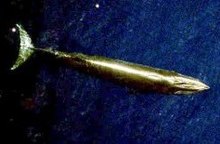Bryde's whale
| Bryde's whales | |
|---|---|
 |
|
 |
|
| Size compared to an average human | |
| Scientific classification | |
| Kingdom: | Animalia |
| Phylum: | Chordata |
| Class: | Mammalia |
| Subclass: | Eutheria |
| Order: | Cetacea |
| Suborder: | Mysticeti |
| Family: | Balaenoptiidae |
| Genus: | Balaenoptera |
| Species: | B. brydei B. edeni |
| Binomial name | |
|
Balaenoptera brydei Olsen, 1913 |
|
|
Balaenoptera edeni Anderson, 1879 |
|
 |
|
| Bryde's whale range | |
Bryde's whale or the Bryde's whale complex (/bruːdə/BREW-də) putatively comprises two species of rorqual and maybe three. The "complex" means the number and classification remains unclear because of a lack of definitive information and research. The common Bryde's whale (Balaenoptera brydei, Olsen, 1913) is a larger form that occurs worldwide in warm temperate and tropical waters, and the Sittang or Eden's whale (B. edeni, Anderson, 1879) is a smaller form that may be restricted to the Indo-Pacific. Also, a smaller, coastal form of B. brydei is found off southern Africa, and perhaps another form in the Indo-Pacific differs in skull morphology, tentatively referred to as the Indo-Pacific Bryde's whale. The recently described Omura's whale (B. omurai, Wada et al. 2003), was formerly considered a "pygmy" form of Bryde's, but is now recognized as a distinct species.
B. brydei gets its specific and common name from Johan Bryde, Norwegian consul to South Africa who helped establish the first modern whaling station in the country, while B. edeni gets its specific and common name from Sir Ashley Eden, former High Commissioner of Burma (Myanmar). Sittang whale refers to the type locality of the species. In Thailand, locals distinguished Sittang whales different from B.edeni, and it is unclear whether Sittang whales were applied for later classified Omura's whales by locals.
In Japan, early whalers called it "anchovy" (鰯 iwashi?) or "skipjack whale" (鰹鯨 katsuo-kujira?). It preys on the anchovy and it was commonly associated with the skipjack. As modern whaling shifted to the Sanriku area, whalemen confused it for the sei whale; now iwashi-kujira (鰯鯨?, "anchovy whale") only applies to the latter. Incidentally, anchovies are dominant prey for both species off Japan. They are now called nitari-kujira (似鯨?, "look-alike whale"), for their resemblance to the sei whale.
...
Wikipedia

